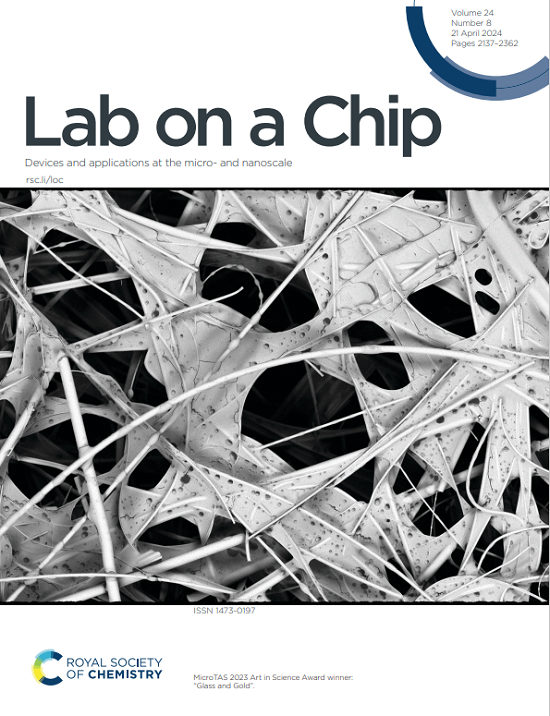Manipulation and 3D characterization of particles and cells through integrated light field microscopy and droplet microfluidics system.
IF 5.4
2区 工程技术
Q1 BIOCHEMICAL RESEARCH METHODS
引用次数: 0
Abstract
Droplet microfluidics (DMF) generates, manipulates and processes discrete sub-microlitre droplets, which allows for precise control and high efficiency in conducting biological assays. On-chip 3D characterization of droplets and samples moving within them is challenging. Light field microscopy (LFM) based on a microlens array (MLA) has emerged as an instantaneous volumetric imaging method, with application to DMF where it can rapidly capture 3D information. However, the trade-off between spatial resolution and depth of field and challenges with reconstruction artifacts have so far limited LFM applications in microfluidics. In this work, a novel integrated system is introduced that combines a DMF device and a bifocal MLA-based LFM system. The system enables precise droplet manipulation alongside on-chip 3D imaging and tracking of particles and live cells in a volume exceeding 500 × 500 × 300 μm3 with a temporal resolution of 100 ms. The LFM has higher spatial resolution and less reconstruction artifacts compared to LFM systems based on conventional MLAs. Experiments applying microbeads and SW480 cells validate the system's capability for effective on-chip sample manipulation and 3D characterization with a best lateral resolution of approximately 1.83 μm and an axial resolution of about 6.8 μm. Additionally, the system successfully demonstrates manipulating rapid on-chip cell lysis and 3D monitoring with a temporal resolution of 300 ms over several minutes, highlighting the synergistic benefits of combining LFM with DMF.通过集成光场显微镜和液滴微流体系统的粒子和细胞的操作和三维表征。
液滴微流体(DMF)产生,操纵和处理离散的亚微升液滴,这允许精确控制和高效率地进行生物分析。芯片上的3D表征液滴和样品在其中移动是具有挑战性的。基于微透镜阵列(MLA)的光场显微镜(LFM)已经成为一种瞬时体成像方法,应用于DMF,它可以快速捕获三维信息。然而,空间分辨率和景深之间的权衡以及重建伪影的挑战迄今为止限制了LFM在微流体中的应用。在这项工作中,介绍了一种新的集成系统,该系统结合了DMF器件和基于双焦点mla的LFM系统。该系统可实现精确的液滴操作,以及片上3D成像和跟踪体积超过500 × 500 × 300 μm3的颗粒和活细胞,时间分辨率为100 ms。与基于传统mla的LFM系统相比,LFM系统具有更高的空间分辨率和更少的重建伪影。应用微珠和SW480细胞的实验验证了该系统有效的片上样品操作和3D表征能力,最佳横向分辨率约为1.83 μm,轴向分辨率约为6.8 μm。此外,该系统成功演示了在几分钟内操纵快速片上细胞裂解和3D监测,时间分辨率为300 ms,突出了LFM与DMF结合的协同效益。
本文章由计算机程序翻译,如有差异,请以英文原文为准。
求助全文
约1分钟内获得全文
求助全文
来源期刊

Lab on a Chip
工程技术-化学综合
CiteScore
11.10
自引率
8.20%
发文量
434
审稿时长
2.6 months
期刊介绍:
Lab on a Chip is the premiere journal that publishes cutting-edge research in the field of miniaturization. By their very nature, microfluidic/nanofluidic/miniaturized systems are at the intersection of disciplines, spanning fundamental research to high-end application, which is reflected by the broad readership of the journal. Lab on a Chip publishes two types of papers on original research: full-length research papers and communications. Papers should demonstrate innovations, which can come from technical advancements or applications addressing pressing needs in globally important areas. The journal also publishes Comments, Reviews, and Perspectives.
 求助内容:
求助内容: 应助结果提醒方式:
应助结果提醒方式:


